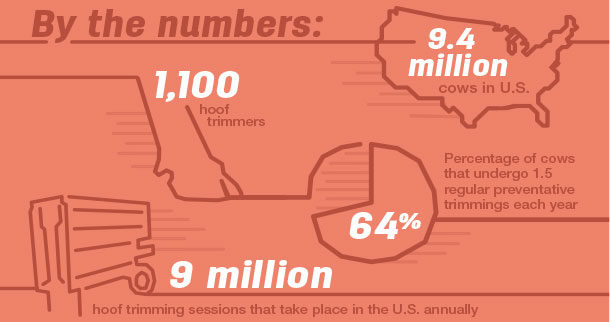Progressive Dairy recently asked leading experts from the Council on Dairy Cattle Breeding (CDCB) to provide an update on their work to better understand dairy cattle hoof health and reduce lameness via genetic solutions.
1. What are the main focuses of your research right now, related to dairy cattle lameness and hoof health?
CDCB: About 50% of dairy cows will be affected by lameness during their productive life, resulting in economic losses, poor health and suboptimal animal welfare. The Council on Dairy Cattle Breeding (CDCB) is working to find genetic solutions to this situation. CDCB and collaborators are working to create a pipeline to collect hoof health data, with the eventual goal to develop genetic evaluations for hoof health-related traits and state-of-the-art tools for management and decision-making.
CDCB is leading collaboration and technical exchanges with the USDA Animal Genomics and Improvement Laboratory, University of Minnesota, Hoof Trimmers Association, Dairy Management Inc. (DMI), Foundation for Food and Agriculture Research (FFAR), and Lactanet. Lactanet hoof health data indicates 46% of Canadian cows experience hoof lesions, with digital dermatitis being the predominant lesion with highest heritability (0.084). This collaboration will foster enhanced technical capacity to collect and process hoof health information, including continuing education for hoof trimmers, standardization of hoof lesion data collected, use of appropriate software and development of a data exchange interface to connect farmers and hoof trimmers with the collaborative databases.
2. Which discoveries, reports or research do you believe are most useful and applicable for dairy farmers?
CDCB: In April 2018, CDCB first published genetic evaluations for six common health disorders – resistance to mastitis, displaced abomasum, metritis, retained placenta, ketosis and milk fever – so dairy producers could directly breed for healthier cows. The implementation of these evaluations resulted from over a decade of research by many institutions, including the USDA Animal Genomics and Improvement Laboratory and CDCB.
Research demonstrated these health events have a genetic component upon which selection can be practiced, resulting in cumulative, permanent improvement in dairy cattle health. In addition to these six health traits, CDCB has made numerous new evaluations available, including cow livability, gestation length, early first calving, heifer livability and feed saved. Many of these traits are currently combined with yield, conformation and fertility traits in genetic selection indices like Net Merit $ (NM$). One of the next top genetic priorities is the improvement of hoof health and reduction of lameness. The result of this research, data collection and trait development is that dairy producers have tools to genetically select for healthier dairy cows.
3. Describe the impact you hope this dairy cattle lameness and hoof health research has on the dairy industry.
CDCB: In the U.S., there are approximately 1,100 hoof trimmers providing preventive and therapeutic care for approximately 9.3 million dairy cows. Assuming that, on average, approximately 64% of cows undergo 1.5 regular preventive trimmings per year, it could be expected that there are around 9 million preventive hoof trimming sessions taking place every year.
Based on these statistics, CDCB believes this represents a realistic opportunity to collect enough hoof health records, or phenotypes, to develop genetic prediction models that will help dairy farmers to select cows that can better resist hoof health and locomotion problems. Furthermore, a hoof health data pipeline would foster the development of management tools to improve efficiency of hoof preventive care and enhance dairy cow health.







